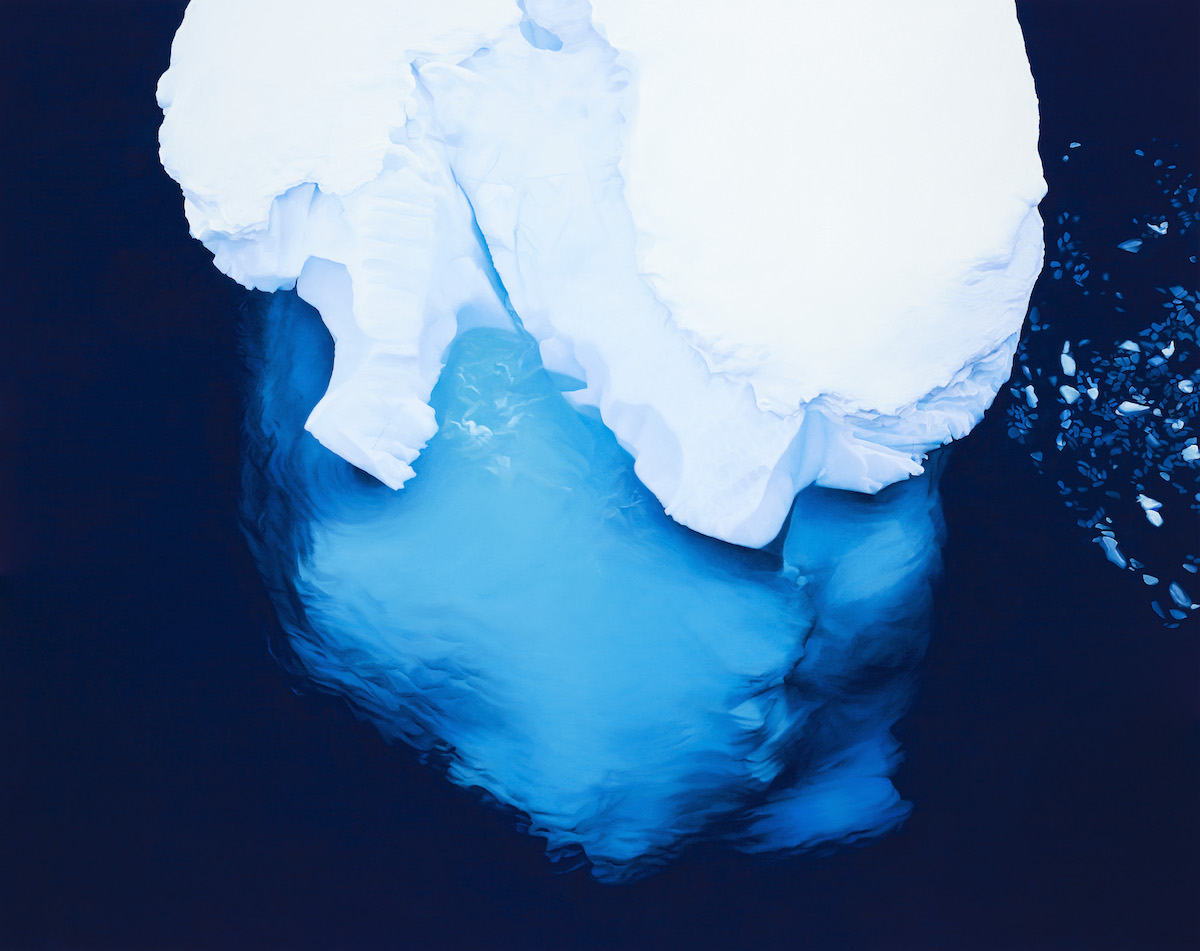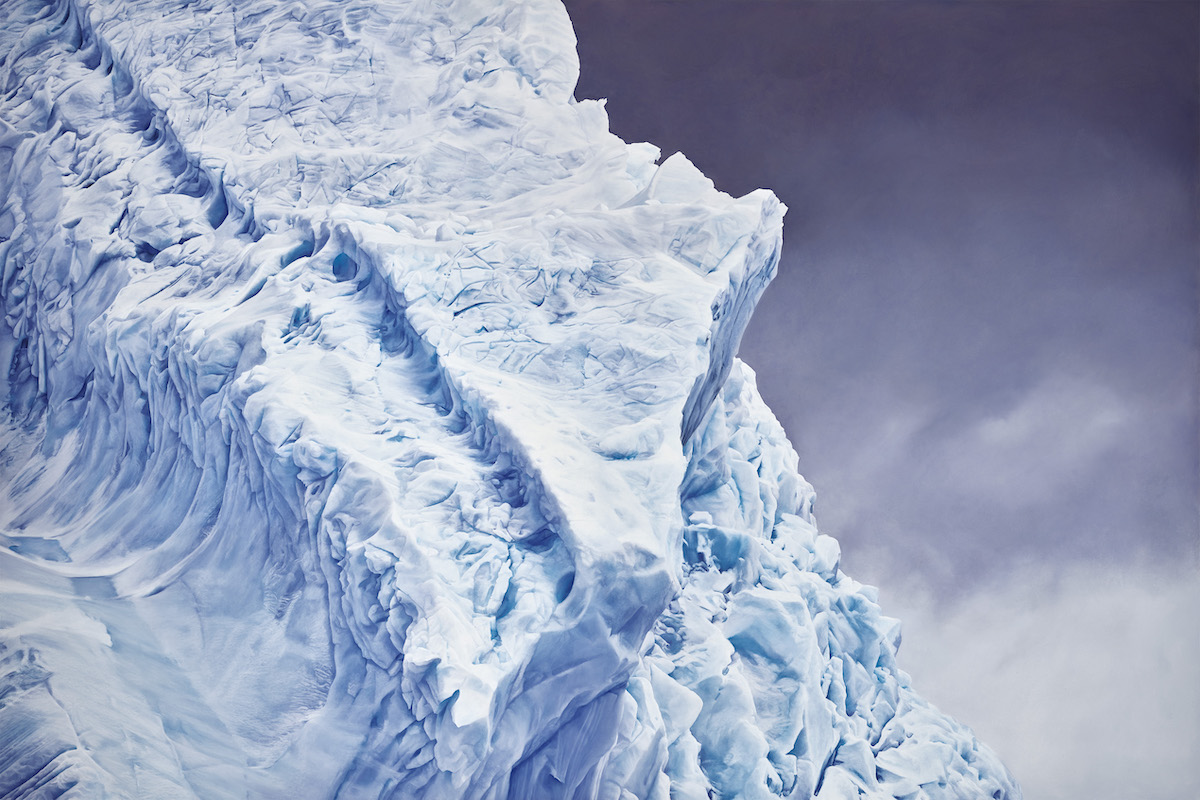Climate change is a crisis that we must all recognize and work together to mitigate. For artists engaging with climate content, their activism manifests in many different ways. Some choose to showcase the devastating evidence of global warming, while others highlight the beauty of the natural world. Part of the latter group, Brooklyn-based Zaria Forman has been engaging with the issue of climate change through her large-scale drawings depicting some of the most beautiful and powerful aspects of the environment, including towering glaciers, crashing waves and melting icebergs. Impeccable to the point of appearing photorealistic, her works are at once serene and turbulent. Using soft pastel applied directly to the paper with her fingers and palms, Forman captures moments that reveal the tenuous balance between nature’s grandeur and fragility, and serve as reminders of what we all stand to lose.
Forman began drawing the natural world at a young age, but it wasn’t until she experienced the impact of climate change firsthand that she grasped the severity of the crisis. In 2007, she took her first trip to Greenland and learned how changes to the ice fjords were challenging the lifestyles of Inuit locals. From then on, her work undertook a larger mission of addressing climate change. In the years since, Forman has traveled around the world to remote locations, even joining several of NASA’s Operation IceBridge airborne missions, for which she flew over Antarctica, Greenland and Arctic Canada, mapping changes in the ice.

Zaria Forman, Wilhemina Bay No.2, Antarctica, November 23, 2018, 58 3/4 x 74 1/8 inches, soft pastel on paper, 2019
It’s on these trips, as well as her own expeditions and partnerships with organizations like National Geographic, that Forman gathers source materials. Traveling to locations that most people never have the chance to see, Forman takes thousands of photographs, which she uses along with memories of how she felt on-site to convey the same sense of awe to the viewer.
This sense of awe is perhaps best seen in her drawings of ice, the bird’s-eye-view works done on her trips with NASA, as well as those featuring close-ups of melting, weeping surfaces. In one powerful work titled Wilhelmina Bay No.2, Antarctica (2019), the artist has drawn an aerial view of a pristine, white iceberg partially submerged in deep blue water. Off to the side are fragments of ice, so faint they appear to be on the brink of melting away. The juxtaposition between the dense, solid iceberg with the tenuous fragments is a vivid reminder of the vulnerability of the natural world.
In other works, Forman showcases the immense scale of nature. In Cierva Cove, Antarctica No.2 (2017), Forman depicted a monumental cliff of craggy ice. The drawing is equally monumental, measuring 70 by 105 inches. The size of the drawing and the foreboding position of the ice, towering over and jutting down towards the viewer, create an impression of incredible strength. Forman has carefully drawn the edges of the ice to convey movement, as if the wind is whipping off of the surface.

Zaria Forman, Charcot Fjord, Greenland 66°21’7.21″N 36°59’10.49″W , April 22, 2017, 90 x 60 inches, soft pastel on paper, 2018
What comes through in Forman’s art is a sense of magnitude: that of nature’s beauty, and of nature itself. Underscoring her work is the magnitude of the climate crisis. For many artists and activists, this magnitude—this weight—is an anxiety-inducing burden. Forman’s approach to the subject is refreshing and offers a necessary break from the more fearful representations of climate change, which are equally important but often daunting. This is not to say that her art is cheerful, but rather her approach is sensitive and nostalgic, offering snapshots of the natural world at a particular, often fleeting, moment.
This balance between fear and awe was the subject of a recent group show at Mana Contemporary in New Jersey that featured Forman alongside artists James Prosek, Catherine Chalmers, Jeff Frost and Ted Kim. Pairing powerful representations of the devastating impact of the climate crisis with poignant yet beautiful images of nature, “Implied Scale: Confronting the Enormity of Climate Change,” was a compelling call to action. Included in the show was Forman’s Charcot Fjord, Greenland 66°21’7.21N 36°59’10.49W, April 22, 2017 (2018), a drawing that the artist completed as part of her work with NASA. Showing an aerial view of bright ice fragments floating in vast, deep blue water, the work is at once dramatic and beautiful. Toward the bottom of the drawing, a large iceberg with water pooling on its surface slowly melts as smaller pieces dissolve nearby, presenting a poetic harbinger of the iceberg’s fate. Though serene and simple, the scene captures the enormity of the phenomenon slowly unfolding below.

Installation view of Implied Scale at Mana Contemporary. Photo: John Berens. Courtesy of Mana Contemporary.
In addition to her activism as an artist, Forman also curated two exhibitions of climate-related art for National Geographic Lindblad Expeditions. Her first show, “Change,” launched in March of 2020 on National Geographic Endurance; her second exhibition, “res.o.lu.tion”, will be installed in October aboard the polar expedition ship National Geographic Resolution. The artists in the exhibitions will join Curate Change, a network Forman founded for artists engaging with nature and the climate crisis as “a place for discourse and collaboration, where new projects, perspectives and solutions are born.” She is also a member of Artists Commit, a group that shares resources on how to make artists’ practices more sustainable and hold their galleries accountable to do the same.
Forman’s next trip will take her to Iceland, a place she’s visited before, but has not had the chance to draw since 2004. In many ways, reflecting on this last point may be superfluous. The changes to the natural world have accelerated in recent years, and the Iceland she saw in 2004 looked different from the Iceland of today. Even places Forman visited just a few years ago, especially those where climate change has taken the greatest toll, no longer look the same. This sad truth is at the heart of the artist’s practice. The beauty of nature, as immense as it is, is fragile and ephemeral. We are continually approaching the point of irreparable damage, and we are all responsible for our collective future.


